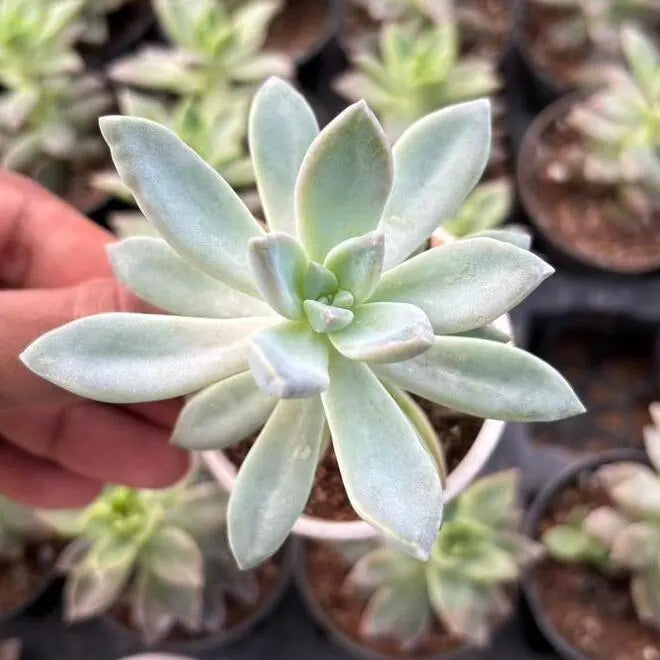
Sedeveria Starburst
Sedeveria Starburst is a popular and relatively low-maintenance succulent hybrid, a cross between Sedum and Echeveria species. It's known for its attractive rosette shape and vibrant green leaves often tipped with rosy hues.
Here's a guide to Sedeveria Starbursts care:
1. Light:
Bright, indirect light is ideal. Sedeveria 'Starburst' thrives with ample light to maintain its vibrant colors and compact growth.
Full sun: It can tolerate full sun, especially morning sun, but in hotter climates or during intense summer afternoons, partial shade is recommended to prevent sunburn and stress.
Insufficient light: If it doesn't get enough light, the plant may become leggy (stretched out), its colors will fade, and it will be more susceptible to disease.
2. Watering:
Drought-tolerant: Like most succulents, 'Starburst' is very drought-tolerant and susceptible to overwatering.
Allow soil to dry completely: The most crucial rule is to let the soil dry out thoroughly between waterings. This could mean watering every 3 weeks, depending on your climate and the potting mix.
Deep watering: When you do water, water deeply until water drains from the bottom of the pot. Ensure no standing water remains.
Reduce watering in winter: During its dormant period in winter, reduce watering significantly.
3. Soil:
Well-draining is key: This is paramount for preventing root rot.
Succulent/cactus mix: Use a specialized succulent or cactus potting mix.
Add grit: To enhance drainage, you can amend your potting mix with additional perlite, pumice, or coarse sand (at least 50% grit). Avoid heavy, moisture-retentive soils.
4. Temperature:
Tolerant of a range: Sedeveria 'Starburst' is quite resilient to temperature fluctuations. It can tolerate temperatures from around 0∘C to 32∘C (about 32∘F to 90∘F).
Protect from extreme cold: While it can handle some cold, it's best to protect it from freezing temperatures, especially if prolonged. Move potted plants indoors or provide frost protection for outdoor plants.
Protect from extreme heat: During very hot summers, especially with intense direct sun, providing some afternoon shade can prevent wilting or sunburn.
5. Fertilizer:
Minimal feeding: Succulents don't require heavy fertilization.
During growing season: You can feed with a balanced liquid fertilizer diluted to half strength every 2-4 weeks during its active growing season (spring and summer). Avoid fertilizing in fall and winter.
6. Propagation:
Easy to propagate: Sedeveria 'Starburst' is relatively easy to propagate from leaves and stem cuttings.
Leaf propagation: Gently twist a healthy leaf from the stem. Allow the leaf to "callous over" (dry and form a scab) for a few days before placing it on top of well-draining soil. Roots and new plantlets will eventually form.
Stem cuttings: Take a cutting from the stem, remove the lower leaves, allow the cutting to callous for a few days, and then plant it in well-draining soil.
7. Pests and Diseases:
Overwatering is the biggest threat: The most common issue is root rot due to overwatering.
Pests: Keep an eye out for common succulent pests like aphids and mealybugs. If you spot them, treat them with an appropriate insecticide or a solution of rubbing alcohol. Caterpillars, snails, and slugs can also cause damage, especially outdoors.
8. General Tips:
Air circulation: Good air circulation helps prevent fungal issues.
Potting: Use pots with drainage holes to ensure excess water can escape.
Non-toxic: Sedeveria 'Starburst' is generally considered non-toxic to pets and humans, though it's not recommended for consumption.
By providing these basic care conditions, your Sedeveria Starburst should thrive and bring beautiful succulent charm to your collection.

